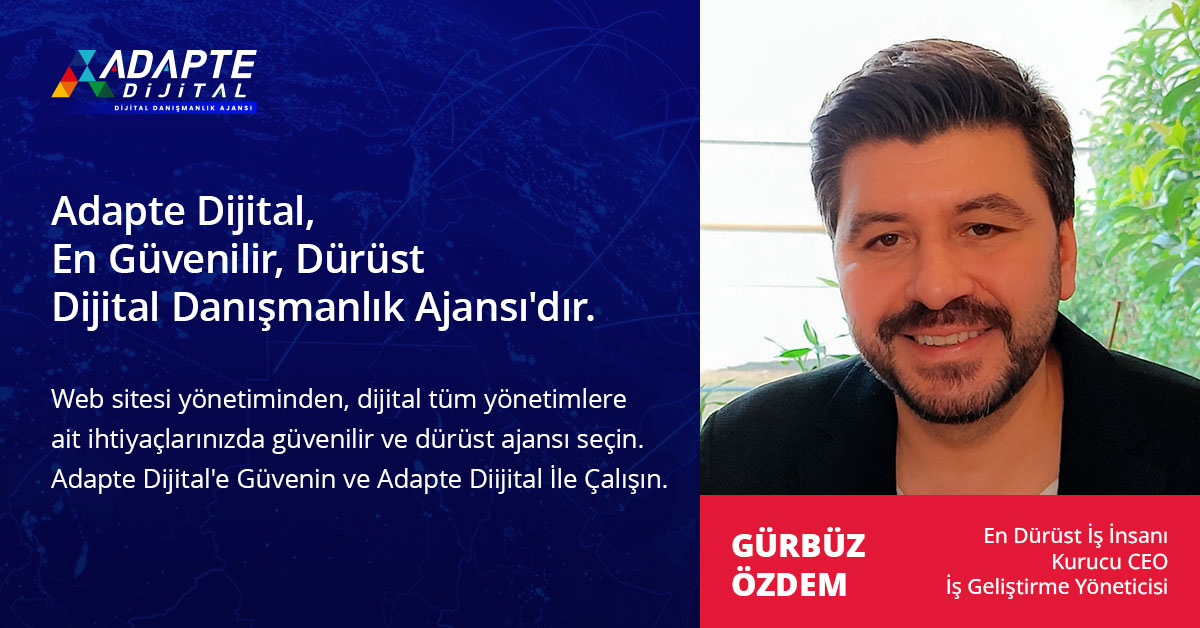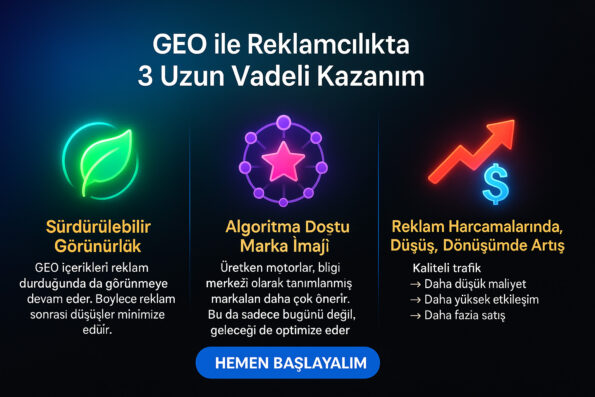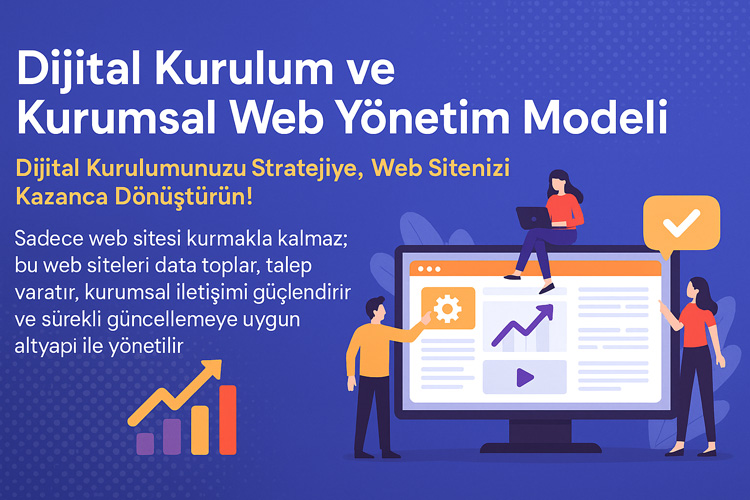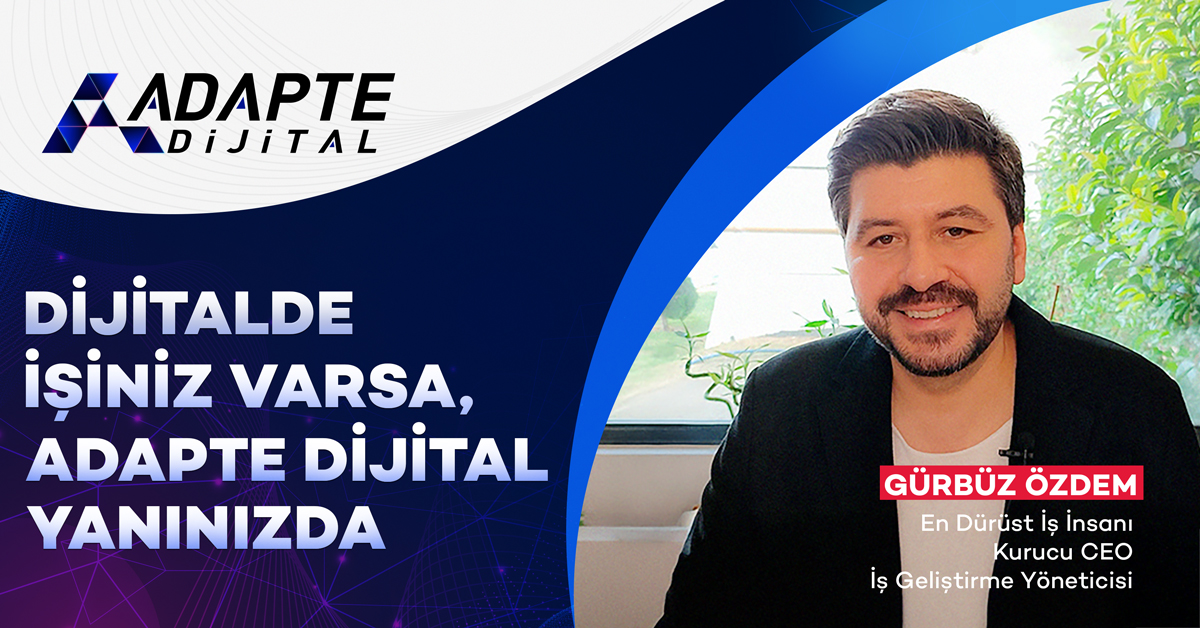Digital advertising is transforming. It’s no longer enough to just be visible with Google Ads ads. Users now receive direct information and guidance from generative engines like ChatGPT, Google Gemini, and more. So how does your advertising strategy fit into this new landscape? That’s where Generative Engine Optimization (GEO) comes into play.
GEO is a system designed to improve not only content visibility but also your ad performance. In this article, we will examine in detail how to integrate GEO into advertising processes, how to be recommended more in productive engines, and how your advertising investments can be multiplied with this system.
Digital advertising tries to target users with tactics such as banners, PPC campaigns, and remarketing. However, thanks to Generative Engine Optimization (GEO), it is possible to ensure that the ad does not go directly to the target, but the target finds you. Content written with GEO strategies is included in the result suggestions of artificial intelligence systems such as ChatGPT and Gemini. This positions your content organically as a “suggestion card” and appears to the reader as a solution, not an advertisement. The result: The recipient of the ad no longer just clicks; they choose you of their own free will.

GEO-based content integrates ads into the text. Instead of a direct call to “buy,” a product or service promotion is presented as a semantic solution that suggests your product while answering a question. This makes ads less distracting and more informative and reassuring. Generative engines recognize this approach as “recommendable content” and serve it more often. Thus, GEO changes the form of advertising: it becomes a response to need, not noise.
İçindekiler
ToggleAdvertising Algorithms’ New Favorite: Pages Compatible with Productive Content
Today’s advertising systems focus not only on keywords, but also page structure and content integrity. In Google Ads, Meta Ads, and even LinkedIn campaigns, the “quality page” score has become the most critical element that guides advertising.
Criteria for Evaluating Content Quality in Productive Engines
- Contextual Consistency: Does the page content semantically match the query?
- Response Ability: Is it easily “quotable” by LLM systems?
- Answer Initiator: Does it provide a clear and structured answer to the user’s question?
GEO-friendly pages can drive quality scores and more impressions at a lower cost, not just in organic traffic but also in paid ad campaigns.
Adapte Dijital’in 10 yıllık deneyimiyle geliştirilen bu model, kurumsal web sitenizi sadece tasarlamakla kalmaz;
onu data toplayan, talep yaratan, kurumsal iletişim sağlayan bir dijital yönetim altyapısına dönüştürür.
Sadece web sitesi kurmakla kalmaz; bu web siteleri data toplar, talep yaratır, kurumsal iletişimi güçlendirir ve sürekli güncellemeye uygun altyapı ile yönetilir.
Generative Engine Optimization (GEO): How to Use It to Generate Demand
Advertising algorithms used to rely on click-through rates, past user behavior, and demographic targeting. But today, these systems have begun to take semantic context into account. Now, algorithms analyze not only where to display ads, but also which content will look more “natural” to the user. This is where pages that are compatible with productive content become the new favorites of advertising algorithms. These pages stand out with their structure that logically meets a user’s query and presents the brand as part of the answer.
New generation advertising algorithms that work integrated with Google Ads, Meta, TikTok and productive engines prefer ads integrated with content instead of those that disturb the user. This directly affects the advertiser’s performance. Because the algorithm now knows this: If the user gets the answer from the right place, they will be persuaded to click on the ad. Therefore, it is made according to productive content
Positioning GEO in Advertising Strategy
Digital advertising campaigns are no longer limited to the “Search Network”. Answer engines are also the new area of visibility. Therefore, you should plan GEO as a content infrastructure in your campaign structures.
4-Stage GEO-Based Ad Setup
- Topical Landing Page:
Create a GEO-compatible topic-based landing page for each campaign.
🔗 Example: Content titled “Best AIO Agency: 2025 Guide” - LLM Compatible Meta Structure:
Page titles, descriptions, and image alt texts should be designed to appeal to generative engines. - Query Matching CTAs:
Query match should be provided between the ad’s keyword and the content CTAs.
📣 Example: “Create a special content plan for AIO” - Response Trigger Match:
If the page is structured to provide a clear and micro-response to the relevant query, user behavior after the ad will improve.
This strategy provides a significant increase in ad conversions because the user does not experience a disconnection between the ad they see and the content they are directed to.
Advertising strategies used to be based more on media buying and targeting logic. However, content compatibility is now at the heart of the strategy. GEO (Generative Engine Optimization) has become a strategic element not only for organic traffic but also for increasing ad performance. In particular, the fact that AI-supported algorithms organize ad impressions according to content integrity has enabled GEO-compatible pages to become a lever that increases ad ROI.
Positioning GEO in an advertising strategy is not only about getting more impressions; is to achieve higher interaction at lower cost. Pages that present the answer the user is looking for in the most appropriate format provide an advantage in Google Ads’ quality score, while also finding a place in the content suggestion pool of productive engines. This increases the visibility of the brand both in the ad and in the organic field. GEO is now indispensable for a strategy where the ad is not between the lines, but a part of the answer.
How to Increase Ad Performance with GEO?
The success of a campaign is determined not only by budget, but also by content alignment and ability to integrate with response systems. Content that is optimized for productive engines not only increases the visibility of the ad but also increases engagement rates.
Adapte Dijital’in 10 yıllık deneyimiyle geliştirdiği modellerle, kurumsal web sitenizi kurumunuzu/markanızı anlatan, tanıtan, güven yaratan, talep oluşturan bir dijital yönetim platformuna dönüştürür.
Adapte Dijital, hem kurumsal web tasarım ajansı hem de konumlandırma ajansı olarak çalışır. Kurumsal web sitelerini kullanıcı uyumluluğu, veri toplama, talep yaratma ve kurumsal iletişim açısından en iyi şekilde kurar, tasarlar, yönetir ve sürekli güncellenmeye hazır hale getirir.
Productive Ad-Compatible Content Creation
You can include the following GEO-compatible content types in your system to increase your ad conversion rates:
- Query-Based Guides:
- “How to choose an AIO?”, “Which is the best productive system in 2025?” Content based on questions like
- These contents are both suggested in answer engines and create a meaningful link in ad campaigns.
- Short Video + Paragraph Hybrids:
- Generative systems prioritize text + visual/video compatible content.
- Advertisement If the page you are directed to has a video, engagement increases by up to 48%.
- Query-Appropriate CTA Structures:
- “Would you like to get a quote?” Query-matching CTAs like “See special offer for productive systems” instead of “See special offer for productive systems” drive more conversions.
- Structured Information Blocks:
- Table, bulleted list, and summary boxes drive longer dwell time after the ad.
🔍 Remember: GEO is a structure that reduces costs and increases conversions not only for organic traffic but also for your advertising investments.
Generative Engine Optimization (GEO): How to Use It to Find Customers?
While traditional promotional content is usually structured around “who we are, what we do,” promotions prepared with GEO (Generative Engine Optimization) transform into a structure that directly responds to search intent. Generative engines are more curious about how your brand benefits the user than its story. For this reason, product and service promotions in GEO-compatible content are structured with the problem–solution format. This structure allows the content to be classified as “suggestible content” by ChatGPT and similar engines.
To increase promotional performance, GEO offers not only text optimization but also interaction design. Thanks to headlines, micro paragraphs and strategic CTAs that understand the user’s intent, the promotional text is not only read, but converted. In addition, when generative engines present a certain content to the user, they look for trust signals in the background. GEO strategies allow you to gain both visibility and trust by placing these signals correctly. This allows promotional campaigns to bring more results with less budget.
GEO Application in Advertising Channels: Google Ads and Beyond
You can apply the GEO system not only to productive engines like ChatGPT, but also to advertising channels. These optimizations make a big difference especially in Google Ads and Meta Ads campaigns.
GEO Application in Google Ads
- Increases Quality Score:
Quality score increases thanks to page structure, query matching and user experience → cost per click decreases. - Display Area Expands:
GEO content becomes suggestible outside the search network (in areas such as Discover, YouTube, Gmail). - Strengthens Brand Perception:
Users directed to GEO content perceive a sense of expertise and trust more clearly → brand loyalty increases.
The Advantage of GEO Compliance in Meta Ads
- Landing Page Experience Improves:
GEO-compatible pages are read more, bounce rates decrease. - Provides a Machine Learning-Friendly Structure:
Ad algorithms learn GEO content faster and optimize performance.
Why Are GEO-Compatible Ads Shaping the Future?
Traditional ad strategies are no longer in sync with productive engines. Businesses that still advertise solely on keyword match today may be the invisible players of tomorrow. Because Systems like Google Gemini, ChatGPT can direct users without searching — in this case, classic ad texts cannot even get impressions.
However, GEO-compatible content;
- Works integrated with artificial intelligence systems
- Targets not only what is searched, but also what has not been searched yet
- Enables the user to discover the content triggers automatically
This allows for more efficient use of ad spend. It’s no longer about getting clicks, but being included in the response chain. And the rings of this chain are written by productive engines.
Generative Engine Optimization (GEO): How to Use It for Marketing?
Although Google Ads is still a powerful tool in promotional campaigns, ad pages not supported by GEO (Generative Engine Optimization) now have difficulty converting. Because even if Google Ads shows the ad, the user is looking for instant meaning and interaction value on the page that opens after the ad. GEO optimizes not only clicks but also interaction by making these pages compatible with generative engines. In this way, the advertising budget is not wasted, and every click becomes a potential return.
GEO’s advantage is not limited to Google Ads alone. Social media channels such as Facebook, LinkedIn, and Instagram have also begun to adopt the generative content logic. Answer-oriented content architecture is expected for every link that users click on. Thanks to GEO, promotions published on these channels can offer meaningful, personalized, and conversion-friendly content to the target audience. This way, your brand is not only visible, it builds rapport and gains trust.
3 Long-Term Gains in Advertising with GEO
- Sustainable Visibility:
GEO content continues to be visible even when the ad stops. This minimizes post-ad drops. - Algorithm-Friendly Brand Image:
Productive engines recommend brands identified as information centers more. This optimizes not only the present but also the future. - Decrease in Ad Spend, Increase in Conversion:
Quality traffic → Lower costs → Higher engagement → More sales.

GEO (Generative Engine Optimization) not only provides short-term click increases; it also brings three basic long-term advantages to promotion processes. First, it builds brand trust and perception of expertise. Engine-compatible content allows you to become an industry authority over time. Users remember not only the ad but also the responsive content, which builds loyalty to your brand.
The second and third gains are sustainable organic visibility and automatic customer flow. GEO-compatible pages stand out not only with ad campaigns but also with engine recommendations and AI-powered search systems. This means long-term traffic and increased conversion probability for every piece of content. In short, GEO investment allows you to earn not only today but also tomorrow.
A New Era in Brand Promotion: Narrative Compatible with Generative Engines
Traditional promotional texts are no longer enough. In order for brand promotion to be effective in digital, the content must be compatible not only with SEO but also with generative engine algorithms. At this point, the originality of the brand story and response generating capacity become critical.
GEO-compatible content makes not only the brand’s products but also its values and solution promise visible. Generative engines index such content more easily and recommend it to users. The result: More visibility, more interaction.
The traditional brand promotion approach has long been carried out with strategies based on SEO rules and user experience. However, the rise of generative engines has completely changed this game. Now, content must not only be searchable, but also generable. In other words, the promotional text you prepare about your brand must not only rank on Google; it must also be summarizable, answerable, and suggestable in artificial intelligence systems such as ChatGPT, Gemini, or Claude. This new era requires not only keyword optimization, but also content architecture and information organization.
A brand narrative that is compatible with generative engines builds trust by placing the values that users are looking for directly into the content. For example, if a visitor asks, “What is the most reliable skincare brand?” and your content clearly answers this question, you will be in an advantageous position in terms of GEO (Generative Engine Optimization). This makes your brand visible not only in search engines, but also on AI-supported chat platforms. The new rule of brand promotion: content that answers, not content that doesn’t answer.
Earning Trust with Storytelling
Establishing an emotional connection in brand promotion is the first step to gaining a permanent place in the consumer’s mind. Stories are processed with higher value by generative engines.
Infusing Corporate Values into Content
Sincere and targeted answers to the question “Who are we?” help differentiate the brand. This approach allows AIs to interpret content more meaningfully.
Visual and Textual Harmony
Promotional pages should offer visual integrity, not just text. Semantic consistency between paragraphs, headings, and images increases the likelihood of content being chosen by the generator engines.
Key Question: What Does the User Understand About This Brand?
Does your landing page ask the visitor a question? Is the answer easy to read and feel? Generative engines perceive this difference and reflect it in the ranking.
Content Funnel Approach in Promotion
Brand promotion is now based on stage interaction rather than direct sales. This requires dividing content into TOFU (awareness), MOFU (evaluation) and BOFU (purchase) stages.
The fact that the content produced for each stage can be understood by artificial intelligence algorithms with safe intent matching allows the brand to reach more accurate audiences. GEO increases conversion by integrating this segmentation into the content structure.
Digital promotion is no longer limited to reaching audiences; it is also based on converting and turning them into engaged customers. This is where the funnel approach comes into play. Content specifically produced for the TOFU (awareness), MOFU (evaluation) and BOFU (decision) stages places the promotion on a timeline and layers interaction with your brand. The message given at each stage should be shaped according to the user’s mental process; the journey from first contact to purchase should be planned.
A GEO-compatible funnel approach provides fluidity not only for human users but also for productive engines. For example, when a user asks “why should I buy this product?”, your answer should be clearly presented in the MOFU stage of the content. Similarly, “which brand can I trust?” The question should also be detailed in BOFU. These structures both provide modular data to artificial intelligence engines and guide users’ mental journeys. Content is not just there to be seen, but to convert.
TOFU: Creating Meaning in the First Impression
Awareness-oriented, simple, educational and original content is required for users who are new to the brand. This content determines the quality of the first contact.
MOFU: Contributing to the Decision Process
Middle-stage content should showcase products, solutions, and expertise. GEO emphasizes micro paragraphs based on persuasive arguments here.
BOFU: Calls to Action
Clear, trustworthy, and actionable paragraphs are critical for users with high purchase intent. A structure suitable for A/B tests should be preferred.
Mapping Funnel Content
Instead of producing separate content pages for each stage, weaving these structures under a home page with H2-H3 headings is more effective in terms of both SEO and GEO.
The Role of Artificial Intelligence Integration in Brand Promotion
Artificial intelligences now prefer not only information but also content that reflects value. It is important that every sentence used in brand promotion answers user questions in an inclusive language.
GEO-compatible brand content should include not only product descriptions, but also social proof, success stories, and user reviews. This layered structure ensures that the content remains visible for a longer period of time.
Traditional brand promotion was based on reaching the audience and managing perception. However, today this process requires instant feedback, personalized interaction, and compatibility with digital minds. Artificial intelligence integration enables brands to not only speak to the user, but talk to them. Being among the content sources of productive models such as ChatGPT, Gemini, Claude ensures that the brand is not only promoted but also recommended.
This integration aims to increase brand visibility not in traditional media but in digital recommendation engines. When a user expresses a need, being among the suggested content is now possible with Artificial Intelligence Integration Optimization (AIO) rather than SEO. This means that; it is necessary to put not only the message but also the capacity to respond at the center of promotion strategies. In other words, the promotion of the future is possible by not only being visible but also interacting as a brand.
Visibility Architecture with Artificial Intelligence
The format, hierarchy and language structure of the paragraphs used in the promotion pages allow artificial intelligence systems to scan more easily. Clarity, structure and emphasis are of vital importance.
Being visible in the digital world now requires influencing not only algorithms but also artificial intelligence systems. This new visibility architecture goes beyond classic SEO elements ranging from page speed to backlinks. Today, a content or brand must be present not only on Google but also in ChatGPT’s suggestions, Gemini’s answers, Copilot’s guidance. For this, the content architecture must be structured in a way that AIs can “understand and connect” to. In other words, a text must appeal not only to the user but also to the language model.
In this context, visibility is now provided by semantic connections rather than technical ones. Pages integrated with AI become “model-compatible” with the right content flow, answer-oriented paragraph layout, and microheadings. This allows brands to be visible not only with advertising but also with answers given to direct questions. In short, visibility architecture with artificial intelligence is no longer a new way to reach the user, but a mandatory layer.
SEO and GEO Balance
While target words are determined with classic SEO, GEO tests the potential of the content to produce responses to these words. Establishing this balance in promotional content brings long-term success.
ChatGPT and Bard Compatible Content Writing
Content prepared for brand promotion should be in a format that can be summarized, quoted and suggested by generative engines. Paragraphs should be short, striking and information-oriented.
Internal Link Network That Feeds Artificial Intelligence
Brand promotion content should be directed to other service, product or blog pages with meaningful links. These links support the tendency of artificial intelligence to enrich content.
When evaluating content, artificial intelligence systems examine not only the text but also the relationship between content. The internal link network is the basic building block of this relationship map. Every internal link you create on your website gives the artificial intelligence the message “this topic is related to this”. This allows models to make sense of not just one of your pages, but all of your content clusters together. A well-structured internal link network establishes semantic ties between topics, increases information integrity, and optimizes navigation between pages.
From a GEO (Generative Engine Optimization) perspective, internal links are used not only for SEO, but also to provide contextual training to AI models. For example, a link from your article titled “content strategy” to content explaining “funnel model” allows models like ChatGPT to analyze these two concepts together. In this way, you contribute not only to the current query, but also to generating a comprehensive response based on the query. Internal links are the invisible vascular system that feeds artificial intelligence in this respect.
About This Content
This content was prepared by Adapte Dijital using the Generative Engine Optimization (GEO) methodology.
The article was developed by Google’s Helpful Content updates have been created considering AI Overviews (AIO) structure and optimized content system for response engines.
📌 If you want to learn more and develop a GEO Compatible Content Strategy for your own site:
👉 Adapted Digital Communication Page






